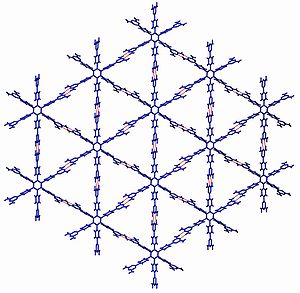- Crystal engineering
-
Crystal engineering is the design and synthesis of molecular solid-state structures with desired properties, based on an understanding and exploitation of intermolecular interactions. The two main strategies currently in use for crystal engineering are based on hydrogen bonding and coordination complexation. These may be understood with key concepts such as the supramolecular synthon and the secondary building unit.
Contents
History of term
The term ‘crystal engineering’ was first used in 1971 by Schmidt[1] in connection with photodimerisation reactions in crystalline cinnamic acids. Since this initial use, the meaning of the term has broadened considerably to include many aspects of solid-state supramolecular chemistry. A useful modern definition is that provided by Gautam Radhakrishna Desiraju, who in 1988 defined crystal engineering as "the understanding of intermolecular interactions in the context of crystal packing and the utilization of such understanding in the design of new solids with desired physical and chemical properties."[citation needed] Since many of the bulk properties of molecular materials are dictated by the manner in which the molecules are ordered in the solid state, it is clear that an ability to control this ordering would afford control over these properties.
Non-covalent control of structure
Crystal engineering relies on noncovalent bonding to achieve the organization of molecules and ions in the solid state. Much of the initial work on purely organic systems focused on the use of hydrogen bonds, though with the more recent extension to inorganic systems, the coordination bond has also emerged as a powerful tool. Other intermolecular forces such as π…π, halogen…halogen, and Au…Au interactions have all been exploited in crystal engineering studies, and ionic interactions can also be important. However, the two most commonly used strategies in crystal engineering exploit hydrogen bonds and coordination bonds.
Molecular self-assembly is at the heart of crystal engineering, and it typically involves an interaction between complementary hydrogen-bonding faces or a metal and a ligand. By analogy with the retrosynthetic approach to organic synthesis, Desiraju coined the term “supramolecular synthon”[2] to describe building blocks that are common to many structures and hence can be used to order specific groups in the solid state. The carboxylic acid dimer represents a simple supramolecular synthon, though in practice this is only observed in approximately 30% of crystal structures in which it is theoretically possible. The Cambridge Structural Database (CSD) provides an excellent tool for assessing the efficiency of particular synthons. The supramolecular synthon approach has been successfully applied in the synthesis of one-dimensional tapes, two-dimensional sheets and three-dimensional structures. The CSD today contains atomic positional parameters for nearly 300 000 crystal structures, and this forms the basis for heuristic or synthon-based or "experimental" crystal engineering.
In two dimensions
The study and formation of 2D architectures (i.e., molecularly thick architectures) has rapidly emerged as a branch of engineering with molecules [3]. The formation (often referred as molecular self-assembly depending on its deposition process) of such architectures lies in the use of solid interfaces to create adsorbed monolayers. Such monolayers may feature spatial crystallinity in an investigated time-window, thus the terminology of 2D crystal engineering is well suited [4][5]. However the dynamic and wide range of monolayer morphologies ranging from amorphous to network structures have made of the term (2D) supramolecular engineering a more accurate term. Specifically, supramolecular engineering refers to "(The) design (of) molecular units in such way that a predictable structure is obtained"[6] or as "the design, synthesis and self-assembly of well-defined molecular modules into tailor-made supramolecular architectures"[7].
Polymorphism
Polymorphism is the phenomenon wherein the same chemical compound exists in different crystal forms. In the initial days of crystal engineering, polymorphism was not properly understood and incompletely studied. Today, it is one of the most exciting branches of the subject partly because polymorphic forms of drugs may be entitled to independent patent protection if they show new and improved properties over the known crystal forms. With the growing importance of generic drugs, the importance of crystal engineering to the pharmaceutical industry is expected to grow exponentially.
Specialized journals
Crystal engineering is a rapidly expanding discipline as revealed by the recent appearance of several international scientific journals in which the topic plays a major role. These include CrystEngComm from the Royal Society of Chemistry and Crystal Growth and Design from the American Chemical Society.
See also
- Coordination polymers
- crystal nets (periodic graphs)
- Crystallography
- Laser-heated pedestal growth
- CrystEngComm
- CrystEngCommunity
- Hydrogen bond
- Molecular design software
- Supramolecular chemistry
- Self-assembly
- Molecular self-assembly
References
- ^ G. M. J. Schmidt, Pure Appl. Chem., 1971, (27), 647
- ^ Venkat R. Thalladi, B. Satish Goud, Vanessa J. Hoy, Frank H. Allen, Judith A. K. Howard and Gautam R. Desiraju, Chemical Communications, 1996, 401–402 Abstract
- ^ J.V. Barth, G. Constantini, K. Kern, Engineering atomic and molecular nanostructures at surfaces, 'Nature, 2005, (437), 671–679.
- ^ C.-A. Palma, M. Bonini, T. Breiner, P. Samori, Supramolecular Crystal Engineering at the Solid–Liquid Interface from First Principles: Toward Unraveling the Thermodynamics of 2D Self‐Assembly, Advanced Materials, 2009, (21), 1383–1386 DOI:[8]
- ^ J. A. A. W. Elemans, S.B. Lei S. De Feyter, Molecular and Supramolecular Networks on Surfaces: From Two-Dimensional Crystal Engineering to Reactivity Angewandte Chemie Int. Ed., 2009, (48), 7298–7332 DOI:10.1002/anie.200806339
- ^ J. Simon, P. Bassoul, Design of molecular materials: supramolecular engineering, 2000 Wiley-VCH
- ^ A. Ciesielski, C.-A. Palma, M. Bonini, P. Samori, Towards Supramolecular Engineering of Functional Nanomaterials: Pre-Programming Multi-Component 2D Self-Assembly at Solid-Liquid Interfaces, Advanced Materials, 2010, (22), 3506–3520 DOI:10.1002/anie.200806339
External links
Categories:
Wikimedia Foundation. 2010.

